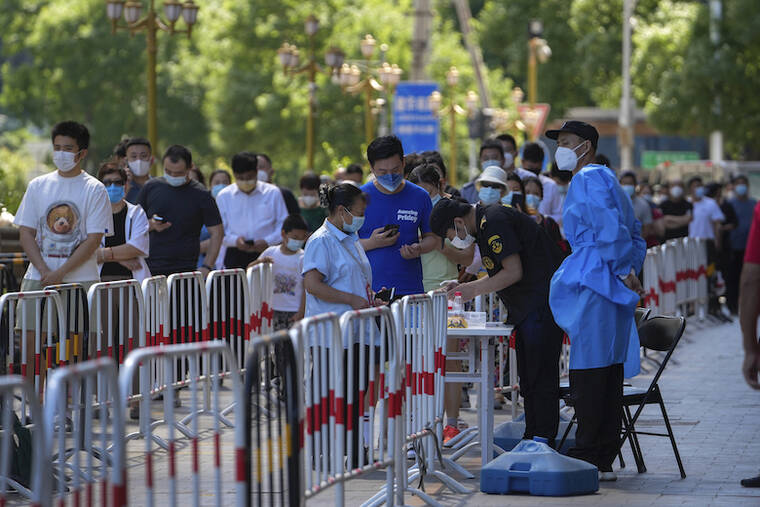China’s virus cases drop below 100 as flareups test COVID Zero

ASSOCIATED PRESS
Residents line up for coronavirus testing set up outside a residential complex in Beijing.
China’s daily virus cases fell below 100 for the first time since early March after months of strict curbs, though omicron’s relentless onslaught and dogged adherence to COVID Zero signals the reprieve may only be temporary.
The country reported 97 new cases for Monday, according to the National Health Commission. The financial hub of Shanghai, formerly the epicenter of the outbreak, reported 31 cases. Beijing found 18, with the city loosening mobility restrictions as its situation comes under control.
China’s success comes after months of harsh restrictions to stamp out transmission, including an unprecedented lockdown of millions of Shanghai residents for nearly two months and strict movement curbs in other regions. But the zero-tolerance strategy has taken an enormous economic and social toll, upended global supply chains and stirred some of the strongest anti-government criticism in years.
While the staunch pursuit of COVID Zero has contained this outbreak — the worst since the early days of the pandemic — the strategy is looking frail in the face of more transmissible virus variants. Officials have been left scrambling to stamp out more frequent flareups before they can take hold, leaving China stuck in a cycle of costly lockdowns as the rest of the world learns to live with COVID.
Health officials have already warned that infection risk in the country’s northeast is growing after cases were found in cities along China’s border with North Korea. Some areas of the key port city of Tianjin are in lockdown after cases flared up and Hebei province, which surrounds Beijing, has reported a growing number of infections.
Even opening up after a lockdown can be complicated. Shanghai has officially been easing restrictions but progress has been slow and some communities have complained their local neighborhood committees were limiting their movements. Beijing is allowing some workers to return to offices and shopping centers to resume business, while schools will stay shut and dining-in at restaurants is banned.
Don't miss out on what's happening!
Stay in touch with breaking news, as it happens, conveniently in your email inbox. It's FREE!
China’s current approach is causing great damage to the economy because the underlying condition for normalcy is a certainty, and any sudden suspension of business and factories is huge uncertainty, said Yanzhong Huang, senior fellow for global health at the Council on Foreign Relations. A more cost-effective strategy would include boosting the elderly vaccination rate and acquiring more oral antiviral COVID drugs.
“If there’s another outbreak coming, China will undoubtedly use the same radical approach,” said Huang. “It will be a long-lasting pain.”



